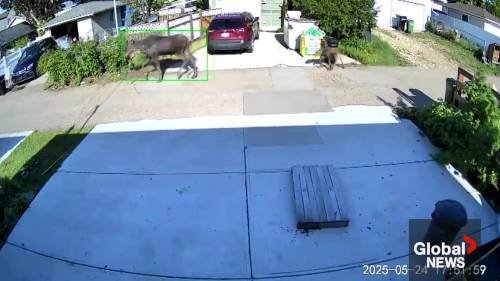Article – As the October light faded on a quiet Edmonton street, Elio Spadon found himself in a dangerous situation that Canadians don’t typically fear in their own backyards. The 75-year-old was collecting leaves in his yard when he had a terrifying encounter with a protective mother moose.
“I went to pick up some garbage, and she was hiding behind the tree,” Spadon recounted from his hospital bed, his voice still shaky from the ordeal. “When I saw her, I tried to run, but she came after me.”
Wildlife encounters in urban settings have become increasingly common across Canadian cities, but few are as dangerous as Spadon’s run-in with the 700-kilogram animal. According to Alberta Fish and Wildlife officials, moose sightings in Edmonton neighborhoods have increased by roughly 30% over the past five years as development pushes into previously natural areas.
The mother moose, protecting her calf nearby, charged at Spadon, knocking him to the ground and trampling him. He suffered multiple broken ribs, a fractured pelvis, and significant bruising across his body. Neighbors who witnessed the attack called emergency services immediately.
“I thought I was going to die,” Spadon said. His wife, Maria, who was inside their home when the attack occurred, heard the commotion but couldn’t reach him in time. “The moose was so big, and Elio is not a young man anymore. When I saw him on the ground, I just screamed.”
Edmonton Police Service spokesperson Cheryl Voordenhout confirmed that officers arrived alongside paramedics to find the moose had retreated to a wooded area behind the neighborhood. “This type of wildlife conflict is rare but extremely serious when it happens,” she explained. “Officers maintained a perimeter until wildlife officials could assess the situation.”
Wildlife biologist Carmen Davidson with Alberta Environment and Protected Areas told me that moose attacks, while uncommon, typically occur when humans unknowingly come between a cow and her calf. “Moose aren’t naturally aggressive, but a mother protecting her young represents one of the most dangerous wildlife encounters possible in urban settings,” Davidson said. “Unlike bears, moose don’t give many warning signs before they charge.”
The incident highlights growing tensions between urban expansion and wildlife habitat throughout Alberta. City councillor Aaron Paquette, whose ward includes several neighborhoods bordering natural areas, has been advocating for better wildlife management strategies.
“We’ve approved developments that push right up against wildlife corridors,” Paquette noted during our phone conversation. “Then we’re surprised when animals like moose, coyotes, or bears show up in people’s yards. We need smarter planning that creates buffer zones.”
For residents in Edmonton’s expanding neighborhoods, particularly those bordering the North Saskatchewan River valley, wildlife encounters have become a growing concern. The city recorded 157 moose-related calls to its 311 service last year alone, according to municipal data—a figure that’s doubled since 2018.
Recovery for Spadon will be slow. Doctors at the Royal Alexandra Hospital expect him to remain hospitalized for at least two weeks, followed by months of rehabilitation. His daughter, Lucia, has started a neighborhood awareness campaign about wildlife safety.
“Dad’s always been careful, but he had no idea a moose was in the yard,” she explained while organizing pamphlets on wildlife awareness. “Most people don’t know what to do if they encounter large animals. We need better education, especially for newer neighborhoods.”
Alberta’s wildlife response team eventually located the moose and her calf about a kilometer from Spadon’s home. Rather than relocating the animals, officials decided to monitor the situation as the pair appeared to be moving naturally away from residential areas.
“Relocation is stressful for wildlife and not always successful,” explained Davidson. “Our protocol is to allow animals to move on their own unless there’s an immediate public safety threat.”
For residents like Mohammed Abukar, who lives three doors down from the Spadons, the incident has changed how he views his own backyard. “I’ve lived here eight years and seen rabbits, porcupines, even a coyote once. But a moose? That’s different. Now I check through the window before letting my kids out to play.”
Wildlife experts recommend several precautions for residents in areas where moose sightings occur. Keep a safe distance—at least 25 meters—from any moose. If you encounter one, back away slowly without turning your back. If charged, get behind a solid object like a tree or vehicle.
As Edmonton’s urban boundary continues expanding northward and eastward, incidents like Spadon’s may become more common without proper planning and education. The city’s Urban Wildlife Management Plan, last updated in 2009, is currently under review with recommendations expected next spring.
For now, Spadon focuses on healing while his neighborhood remains vigilant. “I never thought at my age I’d be fighting a moose,” he said with a weak smile. “Next time I hear something in the yard, I’ll look very carefully before going outside.”
His experience serves as a sobering reminder that even in our urban spaces, we share the landscape with wild creatures that occasionally remind us of their presence—sometimes with dangerous consequences.






